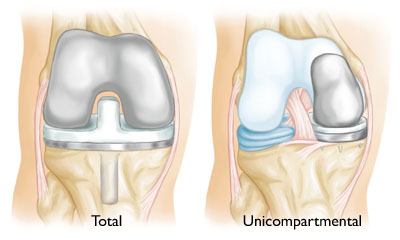By Jaye Sadler, PT –
Now, more than ever, adults are remaining active into the retirement years and beyond. As an increasing number of people make healthy choices about diet and regular exercise, we see a population of older adults who desire to “get the most out of life.” Unfortunately, these lifestyle choices are not always a guarantee that degenerative changes, particularly in the weight bearing joints, won’t hamper the desire to remain active. As a result, more people are electing to have joint replacement surgery.


One of the most common joint replacements is the total knee replacement. The knee is the largest joint in the body and is most susceptible to osteoarthritis or degenerative joint disease (DJD). Knee replacement surgery was first performed in 1968. Since then, improvements in surgical materials and techniques have greatly increased its effectiveness. Total knee replacements are one of the most successful procedures in all of medicine. According to the Agency for Healthcare Research and Quality, more than 600,000 knee replacements are performed each year in the United States.
Causes of Knee Pain
Most knee pain is caused by just three types of disease: osteoarthritis, rheumatoid arthritis, and post-traumatic arthritis. There are four basic steps to a knee replacement procedure:
- Prepare the bone. The damaged cartilage surfaces at the ends of the femur and tibia are removed along with a small amount of underlying bone.
- Position the metal implants. The removed cartilage and bone is replaced with metal components that recreate the surface of the joint. These metal parts may be cemented or “press-fit” into the bone.
- Resurface the patella. The undersurface of the patella (kneecap) is cut and resurfaced with a plastic button.
- Insert a spacer. A medical-grade plastic spacer is inserted between the metal components to create a smooth gliding surface.
When is Surgery Recommended?
- Severe knee pain or stiffness that limits your everyday activities, including walking, climbing stairs, and getting in and out of chairs. You may find it hard to walk more than a few blocks without significant pain and you may need to use a cane or walker.
- Moderate or severe knee pain while resting, either day or night.
- Chronic knee inflammation and swelling that does not improve with rest or medications.
- Knee deformity — a bowing in or out of your knee.
- Failure to improve with other treatments such as anti-inflammatory medications, cortisone injections, lubricating injections, physical therapy, or other surgeries.
After surgery, physical therapy is initiated in the hospital to allow immediate range of motion in the joint, reduction in swelling and early mobility skills.
Patients then have the option of returning home with home health services, or transferring to a rehabilitation facility for short term rehab to allow one to return home safely depending on the support systems in place.
Home Planning
Several modifications can make your home easier to navigate during your recovery. The following items may help with daily activities:
- Safety bars or a secure handrail in your shower or bath.
- Secure handrails along your stairways.
- A stable chair for your early recovery with a firm seat cushion (and a height of 18 to 20 inches), a firm back, two arms, and a footstool for intermittent leg elevation.
- A toilet seat riser with arms, if you have a low toilet.
- A stable shower bench or chair for bathing.
- Removing all loose carpets and cords.
- A temporary living space on the same floor because walking up or down stairs will be more difficult during your early recovery.
The Benefit of Home Health Physical Therapy
Home health physical therapy will continue to train the patient in exercises for range of motion, strengthening, and mobility achieving 90 degrees of bending typically before discharge to an outpatient facility like Progressive Physical Therapy.
Here at Progressive, on your first visit we perform a comprehensive initial evaluation of your strength, range of motion, gait or walking ability and any other factors that may be impeding progress, and set goals for your treatment. We are trained in techniques to facilitate reduction in swelling and inflammation, and will guide you step by step to achieving your therapy goals through hands on treatment, modalities (such as ice, electrical stimulation or ultrasound) and progression of strength and ROM through use of exercises on the mat tables, as well as our full gym of Cybex equipment. Typically, at the completion of outpatient physical therapy, patients will have full pain free active range of motion, normal balance and gait, and a home exercise program to continue independently.
In my experience, patients that have total joint replacement, particularly a total knee replacement, are able to return to the active life they enjoyed prior to surgery, and often times even more.
A New Lease on Life
To learn more, please call Progressive Physical Therapy at 941-743-8700, or visit us online at www.progressivehealthplex.com. Let us help you gain “A New Lease on Life.”
Jaye was born in southern New Hampshire and has resided in the state of Florida since 1996. She has been a therapist for over 20 years, and is married with two beautiful daughters. Jaye graduated from the University of New England in Biddeford, Maine in 1989, and has been practicing in a variety of settings in New England and Florida since that time. Jaye has completed specialized training in manual therapy, and has had experience working in pediatrics, neurology and orthopedic settings. Jaye has been with progressive physical therapy since august of 2008 and enjoys the dynamic setting and challenging caseload.
When not working, Jaye and her family enjoy traveling, camping, and riding horses.
Progressive Health and Racquet Club
914-743-8700
www.progressivehealthplex.com
 Southwest Florida's Health and Wellness Magazine Health and Wellness Articles
Southwest Florida's Health and Wellness Magazine Health and Wellness Articles

